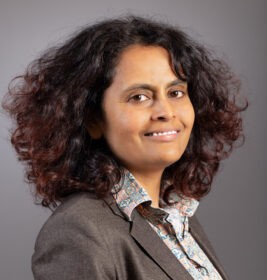From An Age of Monsters to Monstertopia?
By Surekha Davies, author of Humans: A Monstrous History
We live in an age of rising inequality and dehumanization. From anti-immigrant sentiment to transphobia, we are surrounded by claims that difference is dangerous. At the same time, shared qualities that make us all human are being weaponized. US health insurance companies put profit before patient care, denying claims and bleeding patients’ bank accounts dry. CEO pay has ballooned while the US federal minimum wage has remained stagnant since 2009 and the cost of living has risen steeply. Generative AI companies mine copyrighted and personal content for their large language, visual, audio, and video models so that these models can create more convincing content despite their steep ecological and ethical costs. Humanity is being pushed to the margins of the future. How do we live in an age when human beings are increasingly framed as a threat or an inconvenience – or a monster?

In Humans: A Monstrous History, I argue that today’s urgent questions about human rights, labor, wealth, health, technology, and climate justice rest on a foundation of monsters: stories people tell about who counts as fully human, what counts as normal, and who gets cast as the monsters of the body politic. Everywhere from the sports world to policing, monster-making has shaped how we think about science, society, and humanity. We can’t fully understand the present or avoid making the same mistakes in the future without attending to the long history of monsters.
For most people, monsters are primarily the stuff of fiction and trivia, relegated to the spooky corners of the bookcase. But in Humans: A Monstrous History I show that everywhere there are categories there are also, implicitly, monsters: category-breakers. Monster-making processes determine where humanity supposedly ends.
People have defined the human in relation to everything from apes and gods to aliens and zombies. Societies defined beings that lay between and across categories as monsters, and invented race, gender, and nations along the way. Monsters possess a particular kind of otherness: they transgress categories.
Some monster-making happens around human-nonhuman boundaries between humans and ecology, animals, machines, and extraterrestrials. Other monster-making processes define categories within societies – like race and gender – and invent who counts as normal or default, often justifying unequal amounts of rights, resources, and protections. Monster-thinking shapes how people interpret bodies in performance: in art, music, dance, and sport. Attempts to reduce something that exists on a continuum to discrete categories monstrifies whatever is on the boundaries between categories.
Geographers and naturalists in the ancient Mediterranean world identified one-off monstrous individuals as well as entire “monstrous peoples.” Since people’s minds and bodies were believed to be malleable, changing with what they ate, did, and where they lived, extreme environments could, in theory, create monsters: entire societies that ate human flesh, hid in caves, or lived on a diet of smells, for instance.
The age of exploration and colonization was an inflection point for Western monster-making. In the sixteenth century, once European ships were circumnavigating the earth, a new monster question became urgent: where was the boundary between human space and monster space? Would European colonists become irrevocably altered by strange climates?
Categories are stories that shape laws, institutions, and customs. During the era of Atlantic slavery, European powers wrote legal codes that defined enslaved Africans as property. This category distinguished African-descended people from poor white indentured workers. Legislation like the 1661 Slave and Servant Acts of Barbados broke the labor solidarity between white servants and enslaved Africans. Black codes that penalized interracial relationships defined the children of an enslaved woman as enslaved, even if their father was a white enslaver. These codes attempted to maintain a boundary between white and Black, free and enslaved, person and property by disappearing mixed-race children into the category of the African-descended and enslaved. The legacies of Atlantic monster-making persist in systemic racism today.
These are a few of settings in which I show how monsters of science, society, literature, and pop culture illuminate the past and the present. From fairground “giants” who performed their height to women burnt at the stake as witches, people who society framed as looking or acting in ways that challenged norms faced consequences.
We are at a hinge point in history. We could make choices that turn back the tide of rising inequality and allow everyone to flourish, instead of monstrifying people who are, for example, poor, disabled, immigrants, LGBTQIA+, or women. We could legislate to prevent corporations from harvesting the creations of our minds and the data of our lives. Either we help one another out of this maze of monstrifying mirrors, or we’ll be stuck here bashing our fists against our reflections until we melt in a planetary cauldron of our own making.
Instead of vilifying those who are different, we could embrace them – and in so doing give ourselves permission to grow and to experience more fully what it means to be human. We might replace monstrification with monstrofuturism: a way of thinking that celebrates human capacities for growth and creativity and experimental ways of being, free of the fears of conformity. To celebrate the variety of humanity is to give ourselves permission to be our fullest selves, to attend to the basic needs we share with all human beings. For in a world where everyone is unique – a monster – no one is monstrous. A truly utopian future would have to be a Monstertopia.
